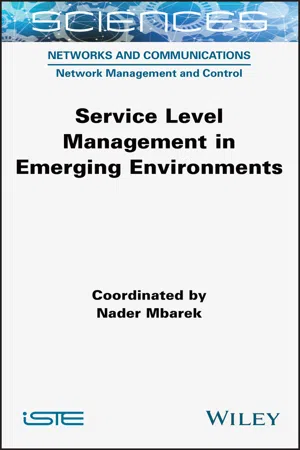
- English
- ePUB (mobile friendly)
- Available on iOS & Android
Service Level Management in Emerging Environments
About this book
Networks are now embedded in daily life thanks to smaller, faster, inexpensive components that are more powerful and increasingly connected. Parallel to this quantitative explosion of communication networks, technology has become more complex. This development comes with challenges related to management and control, and it has become necessary to manage the service level demands of the client to which the service provider commits. Different approaches to managing one or more service level components in different emerging environments are explored, such as: the Internet of Things, the Cloud, smart grids, e-health, mesh networking, D2D (Device to Device), smart cities and even green networking.
This book therefore allows for a better understanding of the important challenges and issues relating to Quality of Service (QoS) management, security and mobility in these types of environment.
Frequently asked questions
- Essential is ideal for learners and professionals who enjoy exploring a wide range of subjects. Access the Essential Library with 800,000+ trusted titles and best-sellers across business, personal growth, and the humanities. Includes unlimited reading time and Standard Read Aloud voice.
- Complete: Perfect for advanced learners and researchers needing full, unrestricted access. Unlock 1.4M+ books across hundreds of subjects, including academic and specialized titles. The Complete Plan also includes advanced features like Premium Read Aloud and Research Assistant.
Please note we cannot support devices running on iOS 13 and Android 7 or earlier. Learn more about using the app.
Information
1
Service Level Management in the Internet of Things (IoT)
1.1. Introduction
1.2. IoT: definitions
1.3. IoT: an overview
1.3.1. IoT architectures
1.3.1.1. The ITU-T reference model

1.3.1.2. The IIC architecture

1.3.2. Application fields of the IoT
1.3.2.1. E-health
Table of contents
- Cover
- Table of Contents
- Title Page
- Copyright
- Preface
- 1 Service Level Management in the Internet of Things (IoT)
- 2 Service Level Management in the Cloud
- 3 Managing Energy Demand as a Service in a Smart Grid Environment
- 4 Managing Quality of Service and Security in an e-Health Environment
- 5 Quality of Service Management in Wireless Mesh Networks
- 6 Blockchain Based Authentication and Trust Management in Decentralized Networks
- 7 How Machine Learning Can Help Resolve Mobility Constraints in D2D Communications
- 8 The Impact of Cognitive Radio on Green Networking: The Learning-through-reinforcement Approach
- List of Authors
- Index
- End User License Agreement